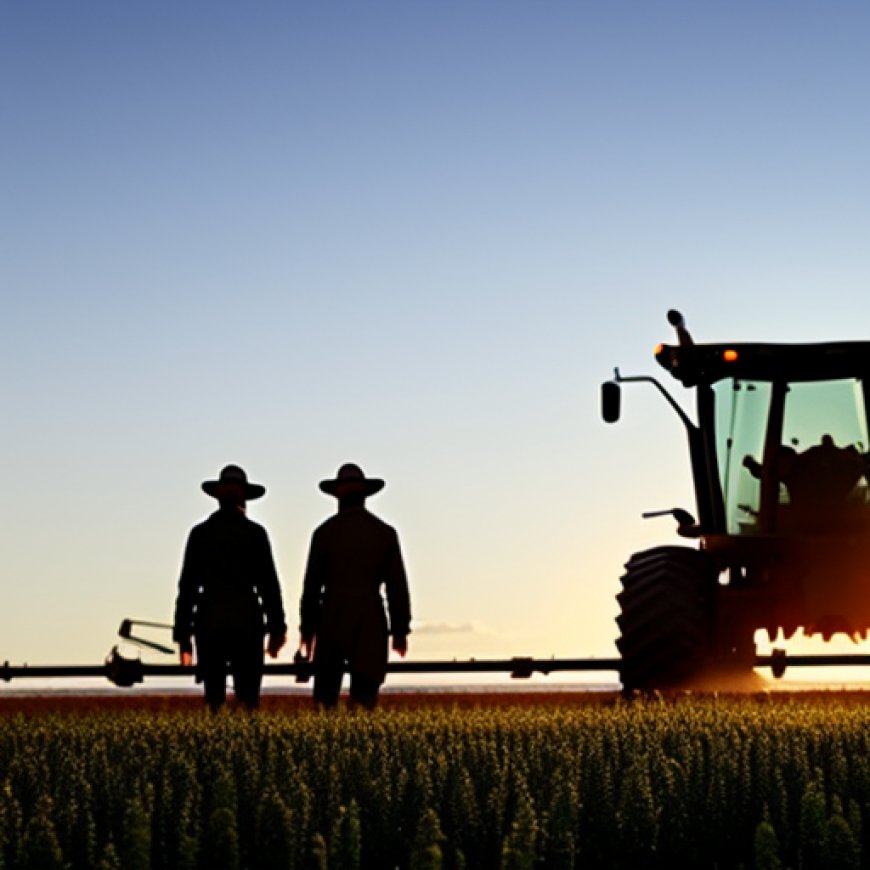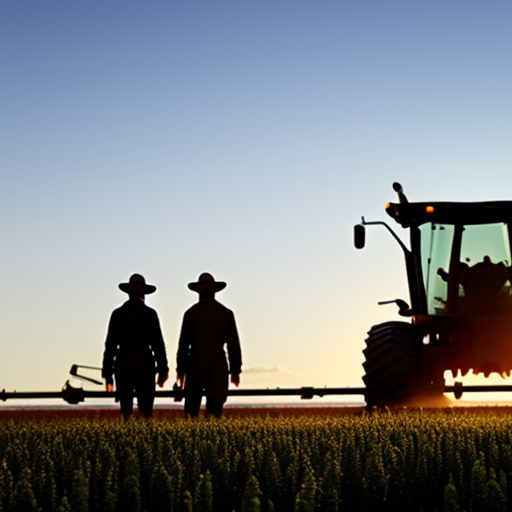Seso: Agriculture Workforce Management Platform Company Raises $26 Million
Seso: Agriculture Workforce Management Platform Company Raises $26 Million Pulse 2.0


Seso Raises $26M in Series B Funding to Expand Workforce Management Platform for Agriculture

Seso, a workforce management platform for agriculture, has announced the successful closing of a $26M Series B funding round. The funding was led by BOND, with participation from Index Ventures, NFX, SV Angel, and other prominent investors. Additionally, several Seso customers also participated in the round.
Expanding the Platform to Support Sustainable Development Goals
The funding will be utilized to expand Seso’s platform and introduce new features that align with the Sustainable Development Goals (SDGs). This includes the development of an AI-enabled payroll solution, a banking and remittance solution for farm workers, and a comprehensive HR platform specifically designed for agribusiness employers. By offering these solutions, Seso aims to help farmers scale their operations to meet seasonal demands and reduce their reliance on traditional pen-and-paper methods.
Addressing Labor Shortages in U.S. Farms
U.S. farms have been grappling with a growing labor shortage for many years. To supplement their seasonal labor needs, many farms have turned to the H-2A visa program, which allows them to hire experienced overseas agricultural workers. Unlike other visa programs, the H-2A visa is uncapped, providing farms with access to a larger pool of workers. Migrant workers who participate in this program have the opportunity to work on American farms and earn significantly higher salaries compared to their home countries.
However, navigating the H-2A program can be extremely challenging, leading to mistakes in visa applications and delayed arrivals for H-2A workers. For an industry where timing is crucial, a delayed harvest can have devastating consequences for a farm’s profitability. Seso aims to streamline the application process for the H-2A visa program by digitizing the paperwork for both workers and employers, ensuring a smoother and more efficient experience.
Empowering Farmers with Digital Solutions
In addition to facilitating the H-2A visa program, Seso also provides farmers nationwide with access to the latest software for managing their back-office workflows and HR documentation. The platform offers comprehensive functionality that enables farmers to effectively manage their workforce.
Since its launch in 2021, Seso has gained significant traction in the industry. Hundreds of farms, including 27 of the top 100 largest employers in agriculture, have adopted Seso as their labor management solution. Last year alone, the company successfully registered over 88,000 workers for seasonal jobs.
Key Quotes:
-
“Any farmer in America will tell you that the biggest risk to their business is labor. We are building the industry’s first digital system of record for farms to hire and manage a seasonal workforce while remaining compliant with government regulations.”
– Michael Guirguis, Seso’s Co-Founder and CEO
-
“Seso has a bold and thoughtful digital vision to help address the labor shortages that have plagued the nation’s agricultural industry for decades. We are excited to partner with Seso as they help farm workers succeed and provide a generational step forward in business software solutions for agriculture employers.”
– Mary Meeker, General Partner at BOND
-
“We are building the most comprehensive HR system ever created for agriculture while ensuring it’s simple and easy to use. Generative AI is going to make a 50-hour payroll reconciliation process take under 5 minutes and will remove the reliance on paper checks and manual data entry for the back-office team.”
– Jordan Taylor, Seso’s Co-Founder and Head of Product
SDGs, Targets, and Indicators
| SDGs | Targets | Indicators |
|---|---|---|
| SDG 8: Decent Work and Economic Growth | Target 8.5: By 2030, achieve full and productive employment and decent work for all women and men, including for young people and persons with disabilities, and equal pay for work of equal value | – Number of agricultural workers provided with decent work conditions – Gender pay gap in the agricultural sector |
| SDG 9: Industry, Innovation, and Infrastructure | Target 9.3: Increase the access of small-scale industrial and other enterprises, in particular in developing countries, to financial services, including affordable credit, and their integration into value chains and markets | – Number of small-scale agricultural enterprises accessing financial services – Increase in the integration of small-scale agricultural enterprises into value chains and markets |
| SDG 10: Reduced Inequalities | Target 10.4: Adopt policies, especially fiscal, wage, and social protection policies, and progressively achieve greater equality | – Reduction in wage gaps between agricultural workers and other sectors – Implementation of social protection policies for agricultural workers |
| SDG 12: Responsible Consumption and Production | Target 12.3: By 2030, halve per capita global food waste at the retail and consumer levels and reduce food losses along production and supply chains, including post-harvest losses | – Reduction in food losses along agricultural production and supply chains – Decrease in per capita global food waste |
1. Which SDGs are addressed or connected to the issues highlighted in the article?
SDG 8: Decent Work and Economic Growth
The article discusses the labor shortage in U.S. farms and how Seso’s workforce management platform aims to help farmers hire and manage a seasonal workforce while remaining compliant with government regulations. This aligns with SDG 8, which focuses on promoting sustained, inclusive, and sustainable economic growth, full and productive employment, and decent work for all.
SDG 9: Industry, Innovation, and Infrastructure
The article mentions that Seso’s platform helps farmers nationwide use the latest software to manage their back-office workflows and HR documentation. This contributes to SDG 9, which aims to build resilient infrastructure, promote inclusive and sustainable industrialization, and foster innovation.
SDG 10: Reduced Inequalities
The article highlights the opportunity for migrant workers to earn higher salaries through the H-2A visa program. However, it also mentions the difficulties farms face in navigating the program, which can lead to delayed arrivals for workers. Addressing these inequalities and ensuring equal opportunities for agricultural workers aligns with SDG 10.
SDG 12: Responsible Consumption and Production
The article mentions that Seso’s platform helps farmers reduce their reliance on pencil and paper, streamlines the H-2A visa program application process, and digitizes paperwork for workers and employers. These efforts contribute to SDG 12, which focuses on promoting responsible consumption and production patterns.
2. What specific targets under those SDGs can be identified based on the article’s content?
Target 8.5: By 2030, achieve full and productive employment and decent work for all women and men, including for young people and persons with disabilities, and equal pay for work of equal value
The article addresses the labor shortage in U.S. farms and how Seso’s platform aims to help farmers hire and manage a seasonal workforce. By providing a comprehensive labor management solution, Seso contributes to achieving full and productive employment and decent work for agricultural workers.
Target 9.3: Increase the access of small-scale industrial and other enterprises, in particular in developing countries, to financial services, including affordable credit, and their integration into value chains and markets
The article mentions that Seso’s platform helps farmers nationwide use the latest software to manage their back-office workflows and HR documentation. By providing access to technology and digital solutions, Seso contributes to increasing the integration of small-scale agricultural enterprises into value chains and markets.
Target 10.4: Adopt policies, especially fiscal, wage, and social protection policies, and progressively achieve greater equality
The article highlights the wage gaps between agricultural workers and other sectors, as well as the difficulties farms face in navigating the H-2A visa program. By addressing these issues and providing a platform that ensures compliance with government regulations, Seso contributes to achieving greater equality for agricultural workers.
Target 12.3: By 2030, halve per capita global food waste at the retail and consumer levels and reduce food losses along production and supply chains, including post-harvest losses
While not explicitly mentioned in the article, Seso’s platform digitizes paperwork for workers and employers, streamlines the H-2A visa program application process, and helps farmers reduce their reliance on pencil and paper. These efforts can contribute to reducing food losses along agricultural production and supply chains.
3. Are there any indicators mentioned or implied in the article that can be used to measure progress towards the identified targets?
The article does not explicitly mention specific indicators. However, potential indicators that can be used to measure progress towards the identified targets include:
– Number of agricultural workers provided with decent work conditions (Target 8.5)
– Gender pay gap in the agricultural sector (Target 8.5)
– Number of small-scale agricultural enterprises accessing financial services (Target 9.3)
– Increase in the integration of small-scale agricultural enterprises into value chains and markets (Target 9.3)
– Reduction in wage gaps between agricultural workers and other sectors (Target 10.4)
– Implementation of social protection policies for agricultural workers (Target 10.4)
– Reduction in food losses along agricultural production and supply chains (Target 12.3)
– Decrease in per capita global food waste (Target 12.3)
These indicators can help track the progress and impact of Seso’s platform and other similar initiatives in addressing the identified targets.
4. Table: SDGs, Targets, and Indicators
| SDGs | Targets | Indicators |
|---|---|---|
| SDG 8: Decent Work and Economic Growth | Target 8.5: By 2030, achieve full and
Behold! This splendid article springs forth from the wellspring of knowledge, shaped by a wondrous proprietary AI technology that delved into a vast ocean of data, illuminating the path towards the Sustainable Development Goals. Remember that all rights are reserved by SDG Investors LLC, empowering us to champion progress together. Source: pulse2.com
Join us, as fellow seekers of change, on a transformative journey at https://sdgtalks.ai/welcome, where you can become a member and actively contribute to shaping a brighter future.
|








